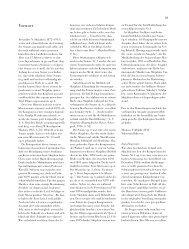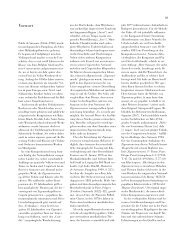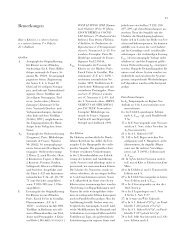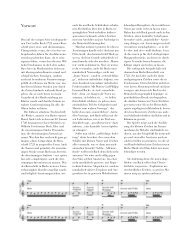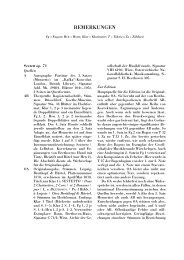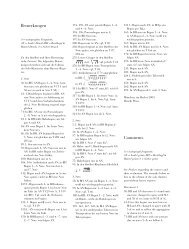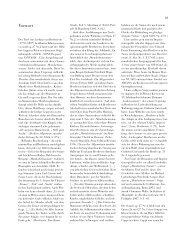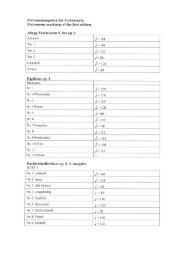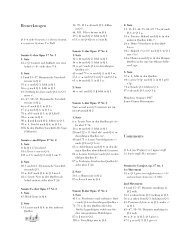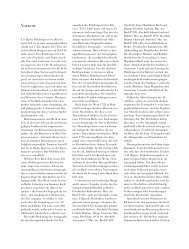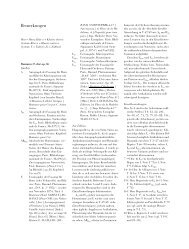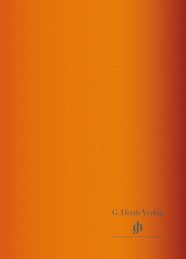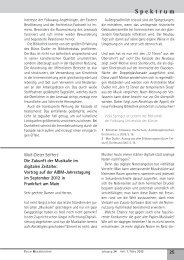Vorwort (PDF, 360 KB) - Henle Verlag
Vorwort (PDF, 360 KB) - Henle Verlag
Vorwort (PDF, 360 KB) - Henle Verlag
Create successful ePaper yourself
Turn your PDF publications into a flip-book with our unique Google optimized e-Paper software.
VIII<br />
[‘No, no, no concertos; just play – keep<br />
improvising at all costs!’] […] After a<br />
considerable time, we turned to Berg’s<br />
Concerto manuscripts and played and<br />
discussed each of the various sections in<br />
some detail” (Louis Krasner, The Origins<br />
of the Alban Berg Violin Concerto,<br />
in: Alban Berg Symposion Wien 1980,<br />
ed. by Rudolf Klein, Vienna, 1981,<br />
p. 111). Given Berg’s emphatically-expressed<br />
wish that he should only freely<br />
improvise (the composer had himself already<br />
worked through the concerto literature),<br />
the date remembered by Krasner<br />
seems rather late – the letters of 7<br />
and 8 June to Webern and Reich prove<br />
that at this time Berg was already working<br />
at introducing the chorale melody<br />
into the second movement. It would<br />
seem much more convincing to date the<br />
meeting so precisely described by Krasner<br />
to around the middle/end of May;<br />
this would tie in with a letter of 20 May<br />
in which Berg asked Erwin Stein (of<br />
Universal Edition) to let him have parts<br />
1, 2, and 4 of Henryk Heller’s Lehre der<br />
Flageolettöne, Berlin, 1928 (letter from<br />
Alban Berg to Erwin Stein, 20 May<br />
1935; now on deposit in the music collection<br />
of the Wienbibliothek im Rathaus,<br />
Vienna, Nr. 419).<br />
After finishing the short score on<br />
15 July, Berg immediately set to orchestrating<br />
the work and, in this connection,<br />
to writing out the full score – not before<br />
once more securing, less than two weeks<br />
later, Krasner’s collaboration on the final<br />
editing: “It will be completely possible<br />
for us to profit from a meeting before<br />
your journey to the USA in order<br />
that we two can lay down the final (that<br />
means perhaps for all time!) version of<br />
the violin part of the concerto” (cited<br />
in Musikblätter des Anbruch 18, 1936,<br />
p. 196).<br />
As early as 14 August Berg informed<br />
the director of Universal Edition in Vienna,<br />
Hans Heinsheimer (1900–93),<br />
that the work was finished and that the<br />
full score would be sent as soon as possible<br />
following a session with Krasner. In<br />
regard to the future production schedule<br />
he noted that the manuscript was “very<br />
carefully written,” and that “an errorfree<br />
copy will easily be possible (with<br />
collation on the part of [Hans Erich]<br />
Apostel). In the meantime I ask for the<br />
following: that you leave the full score<br />
in C (thus untransposed), and have<br />
just the parts for E. H. [English horn],<br />
2 clarinets, saxophone, Bass Clarinet<br />
and 4 horns transposed, by an intelligent<br />
copyist” (postcard to Hans Heinsheimer,<br />
Universal Edition, date of receipt<br />
16 August 1935, Wienbibliothek,<br />
Nr. 422).<br />
Even before Berg and Krasner’s meeting<br />
on 16 September to go through the<br />
composition, Rita Kurzmann (1900–<br />
42) had started on the piano reduction.<br />
She not only worked as Krasner’s accompanist<br />
during his stay in Europe,<br />
but made the important contacts with<br />
the composers of the Second Viennese<br />
School that finally led to the commission<br />
for the Violin Concerto. She first of<br />
all was able to use the autograph full<br />
score as her model; when this went to<br />
the publisher for production of the orchestral<br />
parts, she received the short<br />
score from Berg. Questionable passages<br />
were discussed at a meeting between<br />
Berg and Rita Kurzmann on 5/6 October.<br />
Berg played no part in the rest of<br />
the production process (either of the<br />
parts or the printed edition). He died<br />
of blood poisoning during the night of<br />
24 December 1935.<br />
The première of the Violin Concerto<br />
took place on 19 April 1936 during the<br />
14 th Music Festival of the International<br />
Society for New Music (IGNM) in Barcelona.<br />
Hermann Scherchen conducted,<br />
standing in for Anton Webern, who had<br />
come down with a psychological illness<br />
shortly before. Erich Steinhard, in his<br />
review, probably set down the immediate<br />
impact of the work most powerfully:<br />
“The winds answer, and now introduce<br />
wonderful chorale variations that, after<br />
a powerful ascent, lead to a conclusion<br />
of heavenly tenderness, to a leavetaking<br />
without end. The public was<br />
spellbound. Hermann Scherchen, the<br />
masterly conductor, took Alban Berg’s<br />
handwritten score from the podium and<br />
held it like a Missal before the deeplymoved<br />
audience” (Der Auftakt 16, June<br />
1936, p. 90). On 16 September 1935<br />
Alban Berg had already remarked to his<br />
friend from youth Hermann Watznauer<br />
(1875–1939): “We remain incorrigible<br />
romantics! Even my new violin concerto<br />
reconfirms it” (cited in Stephan, p. 40).<br />
The editor and publisher thank those libraries<br />
listed in the Comments for making<br />
copies of the sources available.<br />
Ammerbuch, spring 2009<br />
Michael Kube<br />
Préface<br />
Après une période d’expérimentation, le<br />
concerto instrumental a atteint lui aussi<br />
au début des années 1930, dans le contexte<br />
d’une consolidation stylistique générale,<br />
un nouvel épanouissement. De<br />
nombreux concertos pour violon de cette<br />
époque sont classés aujourd’hui parmi<br />
les «Klassiker der Moderne», les œuvres<br />
modernes classiques, ceux notamment<br />
d’Igor Stravinski (1931), Alban Berg<br />
(1935), Arnold Schoenberg (1936),<br />
Serge Prokoviev (1937) et Béla Bartók<br />
(1938), Samuel Barber (1938/39), Benjamin<br />
Britten (1938/39), William Walton<br />
(1938/39), Paul Hindemith (1939)<br />
et Karl Amadeus Hartmann (1939). Au<br />
sein de cette série impressionnante, le<br />
Concerto pour violon d’Alban Berg occupe<br />
sans aucun doute une place à part<br />
dans la mesure où il unit de façon singulière<br />
– comme cela ne se trouve que dans<br />
un petit nombre de compositions de<br />
l’histoire de la musique occidentale –,<br />
sous la forme d’une partition autonome<br />
tant pour la forme que pour le matériau,<br />
des éléments extra-musicaux, symboliques<br />
et autobiographiques.<br />
C’est le violoniste américain Louis<br />
Krasner (1903–95) qui donne à Alban<br />
Berg l’idée de cette composition: en février<br />
1935 en effet, il demande au compositeur<br />
de lui écrire un concerto pour<br />
violon. Ils se rencontrent le 1 er mars et le<br />
26 avril pour se mettre d’accord sur un<br />
contrat prévoyant la composition d’un



